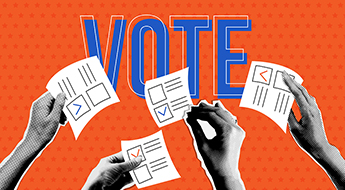New IPR Research: August 2024
Get all our news

This month’s new research from our faculty experts investigates how a family-centered education program in Tulsa supports student parents, visibility and wellbeing in the bi+ community, perceptions of a living wage, and how parent-child discussions can help address subtle racism.
Education and Human Development
A Family-Centered Approach to Helping Student Parents Succeed in Higher Education
Approximately four million people juggle parenthood and college in the United States. How can a family-centered education program in Tulsa support these student parents? IPR faculty researchers Lauren Tighe, Teresa Eckrich Sommer, Terri Sabol, and Lindsay Chase-Lansdale investigate the effects of the program in Annals of the New York Academy of Sciences. The Community Action Project of Tulsa’s CareerAdvance program provides education and career training in healthcare to low-income parents with children. Its original model was centered in Head Start and helped parents achieve postsecondary education while their young children received early education programming. The program also provided numerous supportive services such as free tuition and childcare. The second model, which was based in an adult education and workforce agency and designed to serve the broader Tulsa population, began offering parents similar family-centered support and assistance The IPR team conducted a randomized control trial to evaluate the impacts of the adult model. They surveyed 277 racially and ethnically diverse parents, mostly mothers, 191 of whom received access to the program and 86 who did not. After a year in the program, parent participants were more likely to have obtained a vocational certificate or an associate degree compared to those who did not participate. The study is one of the first to show experimentally that a two-generation program might be effective in promoting student parents’ educational success.
Health Inequalities
Visibility, Relationship Dynamics, and Wellbeing the Bi+ Community
Bi+ people—those who are attracted to more than one gender—are the largest group within the LGBTQ+ community, but they often feel invisible. They also experience greater mental health challenges than people who identify as heterosexual, gay, or lesbian. A study by Emma McGorray, IPR social psychologist Eli Finkel, and Brian Feinstein in Psychology of Sexual Orientation and Gender Diversity explores associations between bi+ individuals’ feelings of invisibility and their quality of life, particularly in the context of romantic relationships. The researchers focus on two main questions: whether feeling visible as a bi+ person is linked to greater wellbeing, and which features of romantic relationships are associated with greater feelings of visibility. The team surveyed 450 bi+ individuals who were single, in same-gender relationships, or in mixed-gender relationships. They found that feeling recognized as a bi+ person was linked to higher levels of wellbeing, especially for those who consider their sexual orientation central to their sense of self. Participants in mixed-gender relationships with heterosexual partners reported a lower sense of visibility compared to those in same-gender relationships and those with bi+ partners. The study also revealed that a bi+ individual may feel invisible even when their partner affirms and recognizes their identity. The researchers encourage clinicians working with bi+ individuals to pay attention to their romantic relationships and partner characteristics and to assess how visible and central these individuals consider their bi+ identity. Finkel is a Morton O. Schapiro IPR Faculty Fellow.
Race, Poverty, and Inequality
Perceptions of a Living Wage
How much money is enough to live on is fundamental to many basic life decisions. In a working paper, IPR adjunct professor Michael Kraus and his colleagues examine how people estimate a living wage, how income shapes their estimates, and how it influences their support for government policies. The researchers asked 1,000 adults across the United States several questions, including what they think is a living wage, the average wage of working adults, and the average wage of workers earning the minimum wage. The participants also reported what they consider to be a basic need, their monthly spending, and their support for redistributive policies. The researchers find that people’s estimates of a living wage are higher than the federal poverty line, the state and federal minimum wage, a popular cost of living calculator called the MIT living wage calculator, and the proposed minimum wage standard of $15 per hour. Participants who reported higher estimates of a living wage were more likely to support redistributive policies, such as expanding programs that improve the living standards of disadvantaged groups or creating a federal job guarantee program. The results show that people generally report a living wage as higher than the federal standard and their beliefs about economic conditions are shaped by their own socioeconomic experiences. Future research should continue to explore income’s influence on perceptions of a living wage and how people calculate leisure as part of a living wage, given its importance for wellbeing.
Parent-Child Discussions Can Help Address Subtle Racism
Experts recommend that White parents discuss racism with their children to reduce racial bias. However, many parents fail to do so. In a study published in Developmental Psychology, IPR psychologist Sylvia Perry and her colleagues investigate what sort of language White parents used in guided discussions of race with their 8–12-year-old children and whether the conversations effectively decreased bias. The researchers recruited 84 White parent and child pairs who participated in a guided discussion task. Parents and their children watched interactions between a White and Black child that showcased overt prejudice, subtle prejudice, or neutral interactions. Following this, parents used suggested discussion prompts meant to facilitate color-conscious conversations, where prejudice was acknowledged, and discourage colorblind conversations, where prejudice was downplayed. Parents and children separately completed implicit association tests to measure their anti-Black bias before and after the task. The results indicated that parents and children who had discussed race showed a significant decrease in anti-Black bias, with parents’ implicit bias score decreasing from 0.53 to 0.34 and children's implicit bias score decreasing from 0.41 to 0.16. Moreover, over 90% of parents and children used color-conscious language during their discussion, and this was associated with decreased bias in both parents and children. Although some parents also used colorblind language during the guided task, this language weakened but did not erase the positive effects of the color-conscious language on bias reduction. Researchers suggest that it is critical for parents to have honest conversations with their children about racism, even from a young age.
Neighborhoods and Community Safety
Officer-Involved Killings of Unarmed Black People and Racial Disparities in Sleep
Research shows that Black Americans are more likely to report that they sleep less than White Americans, putting them at risk for worse physical and mental health outcomes. In a study published in JAMA Internal Medicine, IPR sociologist Andrew Papachristos and his colleagues investigate whether exposure to police officer-involved killings of unarmed Black people is linked to sleep duration in Black communities. The researchers use data on sleep duration from two nationally representative surveys: the US Behavioral Risk Factor Surveillance Survey (BRFSS) and the American Time Use Surveys (ATUS). They examined responses from 181,865 Black and 1,799,757 White adults in the BRFSS and 9,858 Black and 46,532 White adults in the ATUS between 2013 and 2019. They also reviewed data from Mapping Police Violence (MPV), an online database tracking officer-involved killings since 2013. They then used data from both surveys to examine changes in sleep duration for Black adults before and after exposure to officer-involved killings of unarmed Black Americans in their area of residence and nationally. The evidence reveals that Black Americans are more likely to report that they got short sleep—less than seven hours of sleep—or very short sleep—less than six hours of sleep—compared to White Americans after police killed an unarmed Black person. Black Americans reported less sleep when the killing was in the state where they lived. These findings highlight the role police violence can play in shaping racial disparities in sleep duration.
Photo credit: Unsplash
Published: August 28, 2024.


